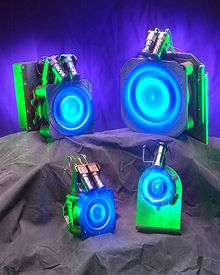Kosmos 2499
Kosmos 2499 (International Designator 2014-028E, catalogue number 39765)[3] is a Russian satellite currently orbiting the Earth.
| Operator | Russia |
|---|---|
| COSPAR ID | 2014-028E |
| SATCAT no. | 39765 |
| Start of mission | |
| Launch date | 23 May 2014, 05:27:54 UTC[1] |
| Rocket | Rokot/Briz-KM |
| Launch site | Plesetsk 133/3 |
| Orbital parameters | |
| Reference system | Geocentric |
| Regime | Low Earth |
| Perigee altitude | 1,156 kilometres (718 mi)[2] |
| Apogee altitude | 1,512 kilometres (940 mi)[2] |
| Inclination | 82.44 degrees[2] |
| Period | 112.19 minutes[2] |
| Epoch | 25 January 2015, 03:55:30 UTC[2] |
Mission
The satellite was launched on May 23, 2014, from Plesetsk, Russia on a Rokot/Briz-KM launch vehicle.[1] Following launch the spacecraft was provisionally described by the NASA Orbital Debris Program Office as Object E until its identity was confirmed.[4] NORAD tracked it under the designation Norad 39765.[5]
Some reports have speculated, based on its unusual powered maneuvers, that it may be an experimental anti-satellite weapon, satellite maintenance vehicle, or collector of space debris.[5][3][6] Chatham House research director and space security expert Patricia Lewis stated that "whatever it is, [Object 2014-280E] looks experimental."[7]
According to an article published on the official Moscow Institute of Physics and Technology website, congratulating the developers on the successful launch and deployment, the satellite is designed to test experimental plasma propulsion engines/ion thrusters, designed by the JSC Reshetnev Company and the Keldysh Research Center.[8][9] The article states that the engines are part of a new generation of Hall effect thrusters and are designed to be able to shift a spacecraft on an east-west and north-south axis using a fraction of the energy required by current propulsion systems.[8][9]

See also
- 2014 in spaceflight
- Cold War II
- Istrebitel Sputnik
- X-37B
References
- McDowell, Jonathan. "Launch Log". Jonathan's Space Page. Retrieved 18 November 2014.
- "COSMOS 2499 Satellite details 2014-028E NORAD 39765". N2YO. 25 January 2015. Retrieved 25 January 2015.
- Brid-Aine Parnell (18 November 2014). "Call 007! SECRET RUSSIAN ORBITAL WEAPON being tracked by NORAD". The Register. Retrieved 18 November 2014.
- "Orbital Debris Quarterly News, Volume 18, Issue 3, July 2014" (PDF). NASA. p. 8. Retrieved 2014-11-18.
- Sam Jones (2014-11-17). "Object 2014-28E – Space junk or Russian satellite killer?". Financial Times.
- Graff, Garrett M. (June 26, 2018). "The New Arms Race Threatening to Explode in Space". Wired.
In the years since, Object 2014-28E has been joined by similar space objects of Russian provenance. Analysts fear that they might mark the revival of a Russian program known as Satellite Killer, which was shut down after the Cold War.
- Andrew Griffin (2014-11-18). "Is Russia flying a satellite killer around space? Unidentified Russian satellite prompts space weapon worries". Irish Independent.
- "Объект 2014−28E". Сделано у нас.
- "Плазменные двигатели нового поколения успешно начали штатную работу в космосе". mipt.ru.
External links
- Jones, Sam (20 November 2015). "Satellite wars". Financial Times. Online. Retrieved 20 November 2015.